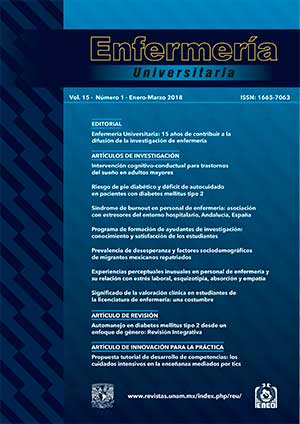Diabetic foot risk and self-care shortfalls among Type 2 Diabetes Mellitus patients
Main Article Content
Abstract
Objective: To explore the risk factors associated with diabetic foot, and the level of knowledge on self-care, in a sample of type 2 Diabetes Mellitus patients (DM2) from an urban health center.
Method: This is an observational and descriptive study in the area of nursing interventions in Primary Attention. Collected data included clinical history, clinical assessment, and the results of an ad hoc questionnaire on DM2 associated risk factors, and the self-care knowledge level. Descriptive and inferential statistics were calculated.
Results: There were 42 male and 31 female patients with a mean age of 69.1 years old. 65.8% had been diagnosed with DM2 longer than 10 years ago. The median value of HbA1c was 6.9%, which was higher among males (p = 0.02). A higher risk of suffering vascular and kidney-related complications was observed among males as well (p = 0.04), whereas a higher presence of deformities such as calluses and hallux valgus was observed among females (p < 0.01). Shortfalls in knowledge, including those on daily feet hydration (p < 0.01) and the use of adequate shoes (p < 0.01) were observed in more than half of these patients.
Conclusions: The control of the related risk factors must be improved by the patients in our study. Moreover, their knowledge shortfalls were related to the inadequate fulfillment of the corresponding recommendations. Thus, and considering the Evidence-Based Practice, it is necessary to better prepare these patients so that they can better control their diabetic foot risks.
Publication Facts
Reviewer profiles N/A
Author statements
- Academic society
- N/A
- Publisher
- Universidad Nacional Autónoma de México
Article Details
Dimensions citation
MÉTRICAS
Enfermería Universitaria by Universidad Nacional Autónoma de México it is distributed under the License Creative Commons Attribution - NonCommercial - NoDerivatives 4.0 International
Accepted and published articles become open-access under the terms of the Creative Commons CC BY-NC-ND 4.0 license, which authorizes the reproduction and sharing without commercial purposes, provided the corresponding acknowledgments to their authors. Authors are allowed to manage a self-archive copy of the article’s published version so that they can open-access it in their personal or institutional web pages, and/or any other broad-diffusion space.


